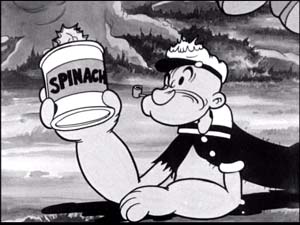Book Extract:The Myth of Redemptive Violence by Walter Wink
The story that the rulers of domination societies told each other and their subordinates is what we today might call the Myth of Redemptive Violence. It enshrines the belief that violence saves, that war brings peace, that might makes right. It is one of the oldest continuously repeated stories in the world. Here Walter Wink describes just how pervasive this myth still is in the mores of Western culture.

Popeye & spinach
The belief that violence ”saves” is so successful because it doesn’t seem to be mythic in the least.
Violence simply appears to be the nature of things. It’s what works. It seems inevitable, the last and, often, the first resort in conflicts. If a god is what you turn to when all else fails, violence certainly functions as a god.
What people overlook, then, is the religious character of violence. It demands from its devotees an absolute obedience-unto-death. This Myth of Redemptive Violence is the real myth of the modern world. It, and not Judaism or Christianity or Islam, is the dominant religion in our society today.
When my children were small, we let them log an unconscionable amount of television, and I became fascinated with the mythic structure of cartoons. This was in the 1960s, when the ”death of God” theologians were being feted on talk shows, and secular humanity’s tolerance for religious myth and mystery were touted as having been exhausted.
I began to examine the structure of cartoons, and found the same pattern repeated endlessly: an indestructible hero is doggedly opposed to an irreformable and equally indestructible villain. Nothing can kill the hero, though for the first three quarters of the comic strip or TV show he (rarely she) suffers grievously and appears hopelessly doomed, until miraculously, the hero breaks free, vanquishes the villain, and restores order until the next episode. Nothing finally destroys the villain or prevents his or her reappearance, whether the villain is soundly trounced, jailed, drowned, or shot into outer space.
Thankfully, not all children’s programmes feature explicit violence. But the vast majority perpetuate the mythic pattern of redemptive violence in all its brutality.
Few cartoons have run longer or been more influential than Popeye and Bluto. In a typical segment, Bluto abducts a screaming and kicking Olive Oyl, Popeye’s girlfriend. When Popeye attempts to rescue her, the massive Bluto beats his diminutive opponent to a pulp, while Olive Oyl helplessly wrings her hands.
At the last moment, as our hero oozes to the floor, and Bluto is trying, in effect, to rape Olive Oyl, a can of spinach pops from Popeye’s pocket and spills into his mouth. Transformed by this gracious infusion of power, he easily demolishes the villain and rescues his beloved.
The format never varies. Neither party ever gains any insight or learns from these encounters. They never sit down and discuss their differences. Repeated defeats do not teach Bluto to honour Olive Oyl’s humanity, and repeated pummellings do not teach Popeye to swallow his spinach before the fight.
… The psychodynamics of the TV cartoon or comic book are marvellously simple: children identify with the good guy so that they can think of themselves as good. This enables them to project out onto the bad guy their own repressed anger, violence, rebelliousness, or lust, and then vicariously to enjoy their own evil by watching the bad guy initially prevail.
This segment of the show – the ”Tammuz” element, where the hero suffers – actually consumes all but the closing minutes, allowing ample time for indulging the violent side of the self. When the good guy finally wins, viewers are then able to reassert control over their own inner tendencies, repress them, and re-establish a sense of goodness without coming to any insight about their own inner evil.
The villain’s punishment provides catharsis; one forswears the villain’s ways and heaps condemnation on him in a guilt-free orgy of aggression. Salvation is found through identification with the hero.
(The Myth of Redemptive Violence from The Powers that Be by Walter Wink, pub. Doubleday 1999)
……………………………




